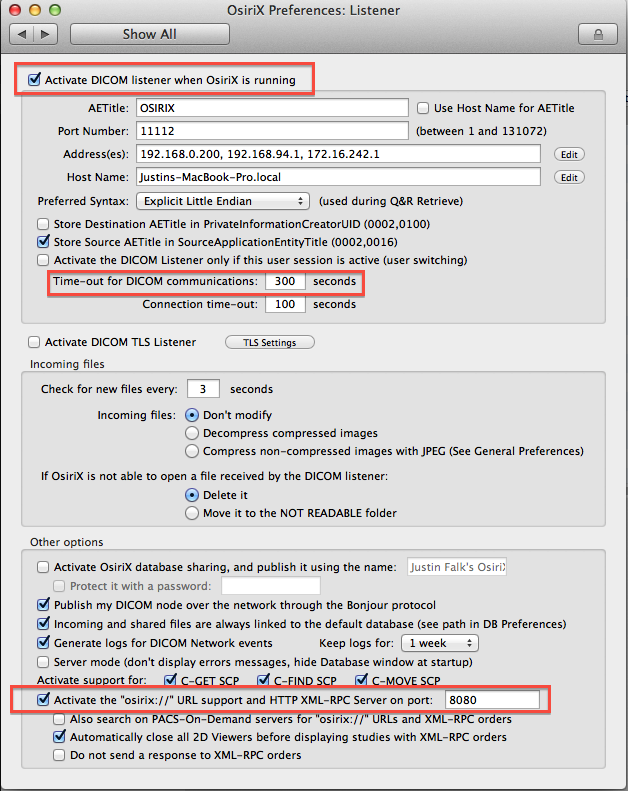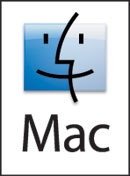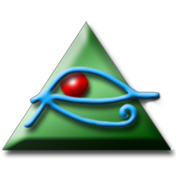Study Retriever for Mac OS X
The Study Retriever is available for Mac OS X. As a DICOM viewer is not included in this package, we recommend the use of the OsiriX viewer along with the OnePacs Study Retriever on Mac OS X.
System requirements for the Mac OS X version are as follows:
- Mac OS X v10.7 or later
- Requires a minimum of 2 GB of RAM, 8 GB or more recommended
- Requires a DICOM viewer application capable of receiving studies by C-STORE, such as OsiriX.
Installation instructions
Installing and Running the Study Retriever
To install the Study Retriever, follow these steps.
1. Drag the Study Retriever icon into the Applications folder. 2. Run the Study Retriever by double-clicking its icon in the Applications folder. 3. To have the Study Retriever run automatically when you log in, select the Open at Login option from the dock menu.
After installing the application, you may eject and delete the Study Retriever disk image.
During normal operation, the Study Retriever creates, and frequently updates, a large number of small files on your disk. This may add a small, but unnecessary, overhead to the Spotlight search indexing process. To avoid that, we recommend excluding the Study Retriever data folder from the Spotlight search database by performing the following steps.
1. Open the System Preferences application. 2. Click the Spotlight icon. 3. Select the Privacy tab. 4. Add the onepacs folder in your home folder to the list of locations excluded from Spotlight.
The latest version of Mac OSX, called Mavericks, has a feature called "App Nap" which puts long running apps into a power saving mode. This can affect the Study Retriever app because it needs to download studies, even when running in the background. Mavericks does have the ability to "Prevent App Nap" for specific applications. It is highly recommended that this option is enabled for the Study Retriever if you are running Mavericks. See http://www.cultofmac.com/253064/how-to-turn-app-nap-off-for-specific-apps-on-your-mac-os-x-tips/ for instructions.
Setting up the OsiriX DICOM viewer to work with the Study Retriever
The Study Retriever can be configured to store and open studies in OsiriX. To enable this integration, follow these steps after installing the Study Retriever.
1. Ensure that the OsiriX DICOM Viewer version 5.0 or later (most recent version recommended) is installed. 2. Launch the OsiriX viewer. 3. Open the Preferences window and select the Listener icon. (See screenshot below)
4. Ensure that the option "Activate DICOM listener when OsiriX is running" is checked. (See screenshot below)
5. Increase the time-out for DICOM communications to 300 seconds (to accommodate very large multi-frame instances). 6. Note the AETitle and port number. You will need to configure the same values in the Study Retriever preferences. 7. Ensure that the option "Activate the osiriX:// URL support and HTTP XML-RPC Server on port" is checked. (See screenshot below) The actual port number can be any value that doesn't conflict with another application running on your computer. The default value of 8080 should be fine in most situations. 8. Open the Study Retriever preferences and configure and activate a store destination with the AE title and port from step (5).
At this point, the Study Retriever will be able to store studies to OsiriX (while OsiriX is running), and to open studies with OsiriX when you select the View command in the Study Retriever download manager window or the OnePacs worklist.
Uninstalling the Study Retriever
To completely remove the Study Retriever from your computer, follow these steps.
1. Quit the Study Retriever if it is running. 2. Drag the Study Retriever icon from the Applications folder to the Trash. 3. Drag the onepacs folder from your home folder to the Trash.
Mac and the Mac logo are trademarks of Apple Inc., registered in the U.S. and other countries.


